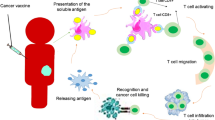Summary
Actinomycin C, Rubidomycin, and Triaziquon were tested in vivo and in vitro against the Ehrlich carcinoma and the GW 77 tumor, a human colon carcinoma that had been transplanted to the hamster cheek pouch. Similar experiments had been done previously with the Jensen sarcoma (Seidel and Wegner, 1969). In addition, Cytosinearabinoside and Hydroxyurea were studied in the GW 77 tumor.
The retardation of tumor growth in vivo was compared with the depression of incorporation of 3H-thymidine and of either 3H-cytidine or 3H-uridine in a 1-hour incubation period in order to find a correlation useful for an estimation of tumor sensitivity.
For the Ehrlich carcinoma the best compound was Actinomycin C. For the GW 77 tumor Actinomycin C and Triaziquon were highly active, and they preferentially depressed the 3H-cytidine incorporation. Rubidomycin, not active in GW 77 in vivo, preferentially reduced the incorporation of 3H-thymidine in both tumors.
The experiments with Cytosinearabinoside and Hydroxyurea, depressors of DNA synthesis, showed a selective inhibition of 3H-thymidine incorporation in the GW 77 tumor. Cytosinearabinoside was very active in vivo, but Hydroxyurea was not. No correlation between in vivo and in vitro data existed.
In further experiments on tumor sensitivity longer incubation times seem to be required, including a whole cell cycle with possible recovery mechanisms.
Zusammenfassung
In Fortsetzung der Versuche am Jensen-Sarkom (Seidel u. Wegner, 1969) wurden die Wirkungen der folgenden Cytostatica am soliden Ehrlich-Ca der Maus und dem in die Hamsterbackentasche transplantierten menschlichen Colon-Ca GW 77 in vivo und in vitro untersucht: Actinomycin C, Rubidomycin, Triaziquon. Nur am GW 77 wurden Cytosinarabinosid und Hydroxyharnstoff geprüft.
Die in vivo erzielten Tumorwachstumshemmungen wurden der in vitro bei 1 stündiger Inkubation gemessenen Einbauminderung für 3H-Thymidin und 3H-Cytidin bzw. 3H-Uridin gegenübergestellt, um eine Korrelation festzustellen, die als Sensibilitätsbestimmung verwertbar sein könnte.
Die Ergebnisse zeigten für das am Ehrlich-Ca am besten wirksame Actinomycin C und die am GW 77 sehr gut wirksamen Actinomycin C und Triaziquon eine bevorzugte Einbauhemmung für 3H-Cytidin, während das am GW 77 unwirksame Rubidomycin bevorzugt den Einbau von 3H-Thymidin herabsetzt.
Die Versuche mit den DNA-Synthesehemmstoffen Cytosinarabinosid und Hydroxyharnstoff am GW 77 ergaben eine selektive Einbauminderung für 3H-Thymidin. In vivo war Cytosinarabinosid sehr gut, Hydroxyharnstoff dagegen nicht wirksam; eine bestimmte in vitro-in vivo-Korrelation bestand also nicht.
Für weitere Versuche zur Sensibilitätsbestimmung in vitro erscheinen längere Einwirkungszeiten, die einen ganzen Zellcyclus mit möglichen Erholungsvorgängen erfassen sollten, erforderlich.
Similar content being viewed by others
Literatur
Chu, M. Y., Fischer, G. A.: A proposed mechanism of action of 1-beta-D-arabino-furanosylcytosine as an inhibitor of the growth of leukemic cells. Biochem. Pharmacol. 11, 423–430 (1962).
Goldenberg, D. M.: Die Verwendung einiger neuer Human-Tumorstämme in der experimentellen Krebsforschung. Teil 1 und Teil 2. Arch. Geschwulstforsch. 29, 1–35 (1967).
Kim, J. H., Eidinoff, M. L.: Action of 1-beta-D-arabinofuranosylcytosine on the nucleic acid metabolism and viability of HeLa cells. Cancer Res. 25, 698–702 (1965).
Pfeiffer, S. E., Tolmach, L. J.: Inhibition of DNA synthesis in HeLa cells by hydroxyurea. Cancer Res. 27, 124–129 (1967).
Seidel, H. J.: Cytostaticatestung an individuellen Tumoren. Acta Histochem. Suppl. 8, 331–342 (1968).
—: Zur Übertragbarkeit von Sensibilitätstesten in vitro auf cytostatische Wirkung in vivo. In: Fortschritte der Krebsforschung, S. 225–228, Hrsg.: C. E. Schmidt und O. Wetter. Stuttgart-New York: Schattauer 1969.
—, Wegner, L. A.: Zur Sensibilitätsbestimmung von Tumoren in vitro. I. Vergleichende Untersuchungen am Jensen-Sarkom in vivo und bei 1 stündiger Inkubation in vitro. Z. Krebsforsch. 72, 105–118 (1969).
Tanneberger, St.: Gewebskultur und Krebschemotherapie. Arch. Geschwulstforsch. 31, 387–400 (1968).
Trepel, F., Stockhusen, G., Rastetter, J., Begemann, H.: Cytostaticawirkungen auf die Nucleinsäure-und Proteinsynthese von benignen und malignen Tumoren. Chemotherapia 12, 182–199 (1967).
Young, G. W., Hodas, S.: Hydroxyurea: Inhibitory effects on DNA metabolism. Science 146, 1172–1174 (1964).
Author information
Authors and Affiliations
Rights and permissions
About this article
Cite this article
Seidel, H.J. Zur Sensibilitätsbestimmung von Tumoren in vitro. Z Krebs-forsch 74, 131–140 (1970). https://doi.org/10.1007/BF00525879
Received:
Issue Date:
DOI: https://doi.org/10.1007/BF00525879




